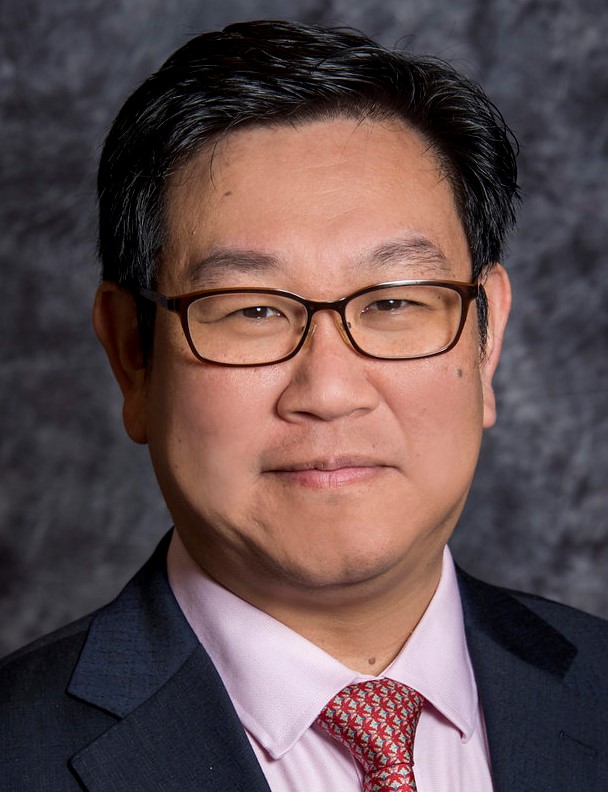
New device developed at the U could lead to improved deep brain stimulation outcomes
Imagine that you’re having a conversation with a friend on a sidewalk. An ambulance with its siren blaring stops right next to you. Do you think that you and your friend will be able to hear each other speak? Not really.

That’s how Michael C. Park (pictured at left), MD, PhD, describes the impact of performing deep brain stimulation (DBS) on a patient who already has an implanted medical device for cardiac stimulation or neuromodulation. “As we do DBS for movement disorders, we record the brain cells’ electrical activity while the patient is awake to localize our stimulation targets,” Park said. “The recording devices we use amplify signals from the patient’s neuronal activity so we can hear it. If the patient already has an implanted medical device, it’s also sending out signals [like the ambulance] that interfere with us being able to accurately record their neuronal activity.”
Today, those devices must be turned off or on a stand-by mode; otherwise, the neuronal recording becomes saturated with signals from the implanted device. “For patients with a cardiac pacemaker, for example, extra precaution is taken to monitor the heart activity during the procedure,” said Park. “We also must turn off deep brain stimulators, which often brings out the patient’s movement disorder symptoms.” While that might be a bit more uncomfortable for the patient, it doesn’t affect the surgical team’s work, according to Park.
Removing the artifacts
The signals put out by existing devices are known as “artifacts.” Being able to accurately monitor and record a patient’s neuronal activity – without artifacts – is critical for a good DBS outcome. The neurosurgeon uses that activity to accurately place the electrode that produces the stimulation to help reduce or eliminate a patient’s symptoms.
“When we do the recording while we explore the targeted area of the brain, we also like to stimulate that area to see the effect,” Park said. “But in both clinical and research settings, you cannot stimulate and record at the same time. If we have the stimulator on, it drowns out what we’re trying to record.”

When Park met Zhi Yang (pictured at left), PhD, Associate Professor of Biomedical Engineering at the U, Yang told him about a device he developed that could potentially overcome that problem. “I immediately knew it was something that might be effective,” said Park. “Dr. Yang had designed a device that would enable you to record and stimulate at the same time, without being concerned about the stimulation artifacts. When he had a device we could test, we decided to use it with Parkinson’s patients who already have one side implanted.”
Exploratory research grant
To help fund this work, Park and Yang applied for and were awarded an R21 grant* from the National Institutes of Health (NIH). The project is titled, Evaluating and Understanding the Effects of Deep Brain Stimulation Using Novel Electrophysiology Technique and Device in Parkinson’s Disease.
The goal, according to Park, is to “develop an artifact-resilient neural recorder and related software suite to support intraoperative monitoring during deep brain stimulation surgery, and to use the device to perform an intraoperative electrophysiological recording of the subthalamic nucleus or globus pallidus internus in Parkinson’s disease patients.” Those are the regions of the brain that when stimulated, provide the most relief from Parkinson’s symptoms.
Park and Yang are co-investigators on the two-year grant and are joined in their efforts by neurosurgery resident David Freeman, MD, PhD; Catarina Saiote, PhD, from Park’s Lab, and members of Yang’s NeuroElectronics Lab. The first year of the grant was devoted to putting the finishing touches on the device that Yang created.
Proving the concept
This year, the research team will test the new device on six Parkinson’s patients who already have deep brain stimulation on one side of their brain. “It’s a proof of concept,” said Park. “We want to understand what will happen if we keep the existing stimulator on and are still able to record from the neurons.”
Park believes it gives the research team a new tool to study the impact of DBS. “It will help us better understand what we’re doing when we stimulate and it’s another way to start designing an improved closed-loop DBS system,” he said. “If you can’t record because stimulation is occurring, you don’t really have a closed-loop system.”
Funding for the project runs through the end of this year.
*This type of grant, according to the NIH, is designed to provide funding for exploratory research that has the potential to lead to advances in health research. Typically, these projects will have little preliminary data in support of the proposed research.



